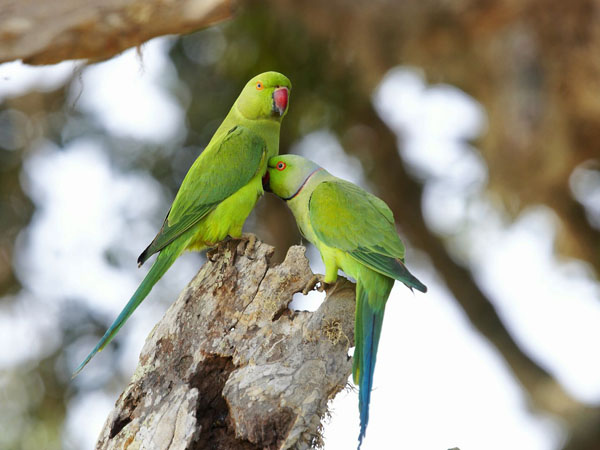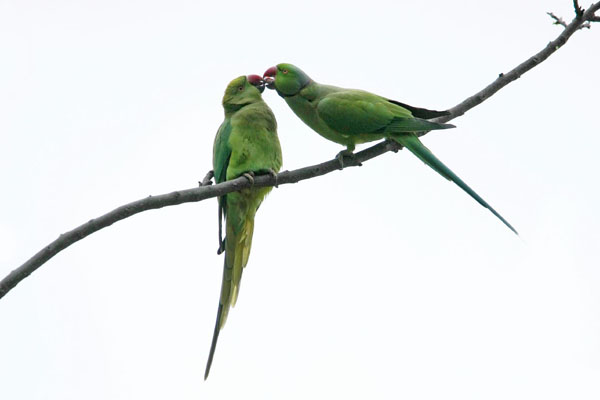Psittacula krameri
IUCN
LCBasic Information
Scientific classification
- name:Psittacula krameri
- Scientific Name:Psittacula krameri,Rose-ringed Parakeet,Rose-ringed parakeet, Ring-necked parakeet, Moon-ringed parakeet
- Outline:Climbing birds
- Family:Psittaciformes
Vital signs
- length:38-42cm
- Weight:95-140g
- lifetime:30years
Feature
The red-collared green parrot has strong adaptability and vitality and is considered a pest to crops.
Distribution and Habitat
China only has the Guangdong subspecies, which is distributed in Fuzhou, Fujian, Zhuhai, Guangdong, Wanshan Islands and nearby coastal areas, Hong Kong and Macau. Abroad, it is found in eastern Africa, India to Southeast Asia, and introduced to Europe.
It lives in tropical monsoon forests or the edge of rainforests, and prefers open habitats with trees. It moves alone, in pairs or in small groups, and often screams during flight.
Appearance
The Red-collared Green Parrot is a medium-sized, long-tailed green parrot with a round and small head. The male has a blue nape and a narrow black cheek pattern that extends to a narrow pink collar on the side of the neck; the female has a green head and body, a blue tail with a yellow tip, a yellow iris, a red beak, a blue wax membrane, and flesh-colored feet.
Details
Red-collared green parrots are resident birds, often moving in groups, sometimes with gray magpies, starlings, crows, etc. They mainly live in open sparse woodlands at the foot of the mountain, as well as villages, farmlands, and town gardens. They make noisy calls, especially in the morning and evening, often making continuous "ga-ga-ga" calls. They fly fast and powerfully, sometimes flying very high, and then suddenly landing on trees. Most of them move in small groups, and will gather in considerable numbers near foraging sites or roosting trees, occasionally up to hundreds. They are very noisy by nature, so they are very obvious and easy to see, and their personality is not very afraid of people; they usually stay in the same area and only migrate to other areas when foraging; they fly very fast and are accompanied by sharp and piercing calls.

Mainly feed on fruits and seeds of plants such as figs and kapok, and also eat grains and other shrub berries, flowers, nectar, etc. During the breeding season, many local Indian red-collared green parrots will gather in large numbers in farming areas to forage for rice, corn, corn, and fruits. They will also go to coffee gardens to forage, often causing considerable damage to crops. When raising them at home, you can feed them some cereals: rice, peanuts, hemp seeds, sunflower seeds, etc., mixed feeding, as well as fruits: apples, corn, etc.
The breeding season in the wild varies from place to place. In India, it is from December to May of the following year, in Sri Lanka, it is from November to June of the following year, and in Africa, it is from August to November. They usually look for tall trees and build nests in tree holes. In India, they also build nests in cracks in the walls of houses.

The red-collared green parrot distributed in China is a caged bird introduced to Hong Kong from other places around 1900. It has been constantly escaping into the wild and gradually formed a wild population in the wild. It is more common in Hong Kong and other places, and sometimes large groups of more than 70 can be seen.
Listed in the second level of China's "National Key Protected Wildlife List" (February 5, 2021).








